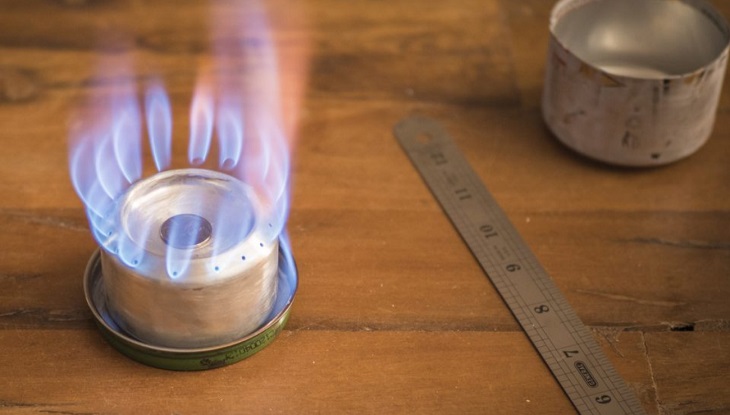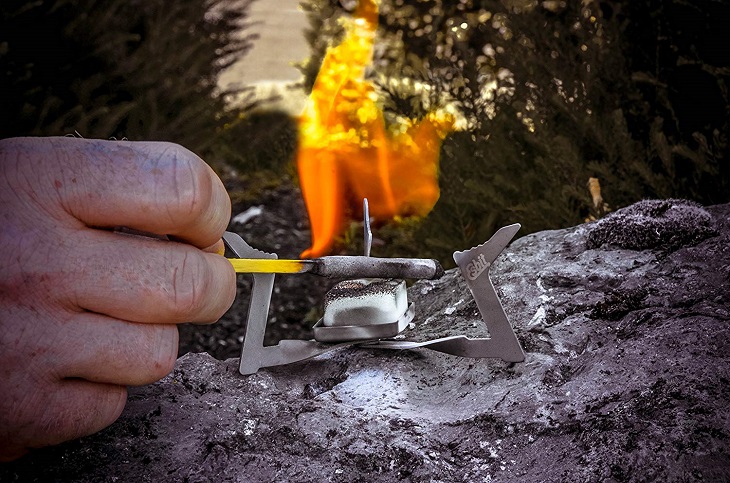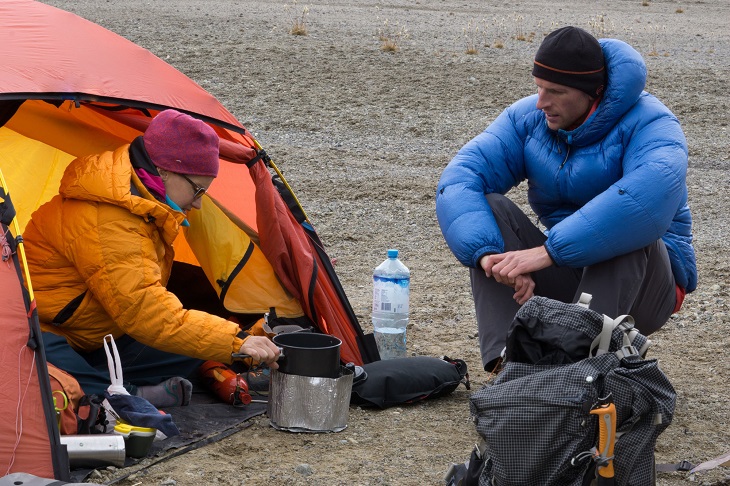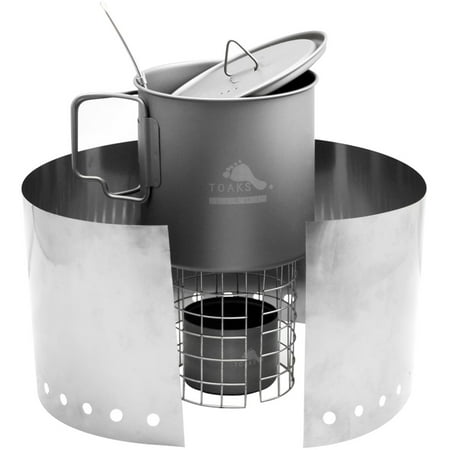Many backpackers, campers and hikers love alcohol stoves because they are lightweight and inexpensive. Plus, you can make them yourself. In this post, we’re going to explore the different types of alcohol stoves and give you one too many reasons why you should have on for your next outdoor trip.

“You get guys around a campfire, and they start telling their stories. That's the fellowship that they want to be in.”
- John Elredge -
Don’t you love it when you reach the summit of your hike and find those breathtaking views that make the climb worth every bit of sweat?
As a hiker, camper, backpacker or outdoor lover, the destination is usually one of the highlights of your experience. Given a chance, you would spend endless nights gazing at the stars and soaking in the beautiful silence of these secluded, yet peaceful times.
To enjoy such moments, you will need a source of heat, both for cooking and to keep you warm on colder evenings, especially when your outdoor journey takes you to faraway places.
If you’re getting to your destination by foot, space in your backpack is a premium, so larger camping stoves are not an option.
Yes, you could build a fire from logs, sticks and brush, but what happens when either the ground is wet, you just want to build a fire quickly. Or if the location you are at prohibits such a fire?
Enter the hero of the day… the alcohol camping stove!
Portable backpacking stoves have been a staple in Europe and with the Boy Scouts, as well as for die-hard hikers and ultralight backpackers, and are now gaining more popularity here in the United States for more casual hikers, trekkers and campers, as well as emergency preppers.
Let's get started with the basics, shall we?
Alcohol Camp Stove FAQs
We hope to answer the most frequently asked questions about alcohol stoves for camping, including how to make them yourself! Want to go directly to a question? Click the link.
What is a Portable Alcohol Stove?

Alcohol Stove’s are cheap & great for camping and trekking. | Photo from REI Article
Alcohol stoves are small, portable sources of energy that use alcohol to produce a flame that can be used to cook or keep warm.
An alcohol stove has become a useful component of a backpacker’s “must have equipment" due to its convenience and countless benefits when outdoors. When homemade, these are popularly known as pop-can stoves, soda-can stoves, beverage can stoves, or just can stoves, depending upon what recycled material is used to make them.
The common structure of an alcohol stove consists of a stand and some type of container, typically aluminum or brass (with some manufactured ones made from durable titanium), that holds the alcohol used to produce the heat energy. You can purchase the pieces needed to put together an alcohol stove already made, or you can make them yourself (we’ll discuss how, further along in this article). Optionally, you can also use a wind screen to increase the performance of an alcohol stove.
Why Are Alcohol Stoves Often Called Soda Can Stoves?
In case you were wondering, the name soda-can, or pop-can stove, depending upon what part of the country you are in, comes from people using actual soda cans and cutting them down to use as the container to hold the fuel for burning. Another variation is the 'cat can stove', which is made from, as you would expect, a cat food can. These are also made from tuna cans, but we suppose 'tuna can stove' doesn’t sound as good since the name hasn’t caught on as a popular term.
The phrase 'hobo stove', reminiscent of traveling workers who carried their belongings on their back, is also used, usually when referring to cooking stoves made quickly from the cans of food they were getting ready to eat.
Video: How to make a cheap easy to operate alcohol stove using aluminum cans
Quick Tutorial: How to Make a Soda Can Stove | Courtesy of REI
Note: More detailed instructions on how to build different kinds of alcohol stoves can be found later in this article.
Fuels that Can Be Used with Alcohol Stoves
There are many different alcohol stove fuels used for combustion, and each has its pros and cons. The best thing about these sources of fuel is that they’re light-weight and burn for a long time — making them perfect for extended periods spent out exploring the outdoors. With an alcohol stove, you can quickly set it up to cook a meal on the hiking trail or burn it for warmth.
Here are some of the most common fuels used with alcohol camping stoves.
Denatured Alcohol
A mixture of mostly ethanol and methyl alcohol, denatured alcohol is at the top of just about every list for the best choice to use as fuel for alcohol stoves. Ethanol is the type of alcohol in alcoholic beverages, but because there are other chemicals added, the denatured version is toxic and not safe to drink. For this reason, most companies add either color or smell additives, or both, to clearly distinguish it. Also called methylated spirit or denatured rectified spirit, this fuel source is inexpensive and readily available.
There are two downsides to denatured alcohol though.
First, it's usually sold in larger containers — much more than you would need for a short excursion or would want to carry in a backpack. Because of this, you will probably want to transfer the amount you need for your trip into a smaller, plastic container with a tight seal. The other negative is that because of it’s composition, it’s not as environmentally friendly as some other options.
Methyl Alcohol (Methanol)
Methyl Alcohol (and the different variations of this wood alcohol) is a type of camp stove fuel that goes by many names — methyl hydrate, liquid fondue fuel, gas line antifreeze, just to name a few. This is an extremely toxic form of fuel, but it has the benefit of vaporizing even at low temperatures. This is why it is often a choice of hikers who need a fuel source for cold weather and winter excursions.
You can find products such as Yellow HEET, which is used by many campers and hiker, at local automotive stores, or you can purchase pure methanol at racing supply stores. This fuel source is one of the most expensive ones that can be used with alcohol stoves.
Isopropyl Alcohol
You know, the stuff you probably have in the medicine cabinet...
Even though there is a high water content, rubbing alcohol (typically about 70% Isopropyl) will work as a fuel for a camping stove. Higher concentrations, such as 99% or 91% Isopropyl alcohol, will work better and can reach temperatures hot enough to boil water.
CAUTION: Do not use higher concentrations for personal hygiene purposes.
There are also isopropyl-based fuel line cleaners that will work in a pinch, but it’s not at the top of our list. The problem with this type of fuel is that it doesn’t burn clean. The yellow flame produces a significant amount of soot.
However, there are companies, such as Real Flame and 7Penn, who sell gelled isopropyl alcohol specifically designed to be a fuel source that can be used both indoors and out — and it burns a bit cleaner than the liquid forms with less soot. These come in their own self-contained canisters so all you need is the stand.
Solid Alcohol Fuel Tabs

Esbit Smokeless Fuel Tablets for Backpacking Camping and Emergency Prep
Are you looking for an alternative to liquid alcohol for your camping stove?
Use a dry alcohol stove — which simply means using an alcohol fuel source that is in a tablet or solid form. One of the benefits of fuel tabs is that they can be blown out without the risk of splashing and spreading fire. They are also lightweight and easy to transport without any concerns of spilling or container breakage.
Most solid fuel tabs are made from hexamine (also known as "hexy") which burns without smoke, doesn't leave ashes and is capable of reaching extremely high heat, up to 1500° F. They are not as sensitive to wind and are better for extreme cold temperatures and high altitudes.
NOTE: Even though you can use Hexamine, which is short for Hexamethylenetetramine, in an alcohol burning stove, it is not technically "alcohol" but rather it's made from formaldehyde and ammonia.
On the down side, hexamine gives off a smell that some people don't like, and it's more expensive than alcohol. Fuel tabs are also more difficult to find on the trail, so you will want to make sure you have enough packed for the trip.
Many hikers who prefer to make "traditional" fires with sticks, logs and brush will pack a few solid fuel tabs in their bags just in case they can't find dry kindling. Some popular brands include Esbit, Coghlan's and Weber.
Want to save some money?
Many hikers, campers and preppers make their own solid fuel sources — some of which are used to start a wood fire, and others which are powerful enough to burn on their own for light cooking and boiling water. The most common "ingredients" for DIY fuel cubes and fire starters are candle wax, paraffin, sawdust and cotton balls.
Look around on YouTube and you will find many different variations, such as these:
Combination Fuels
As you can see, each of these different fuels has it’s own pros and cons. This is why there are many products available that combine different ratios together to create fuels for camping stoves. We already talked about denatured alcohol, but here are a few more examples.
Canned heat (aka chafing dish fuel), commonly seen on banquet tables, is usually a combination of ethanol, methanol and a gelling agent is a favorite of many hikers and campers. This alcohol fuel is safe for both indoor and outdoor use for cooking foods.
Sterno is probably the most well-known brand. So much so, that people often use the term generically for any canned or similar ethanol-based gel fuels made by other companies such as Safe Heat.
Crown Alcohol Stove Fuel and Klean-Strip Green (made with 95% natural and renewable resources) are brands of denatured alcohol that combine a bit of everything to make them clean-burning favorites of many.
You can find them at retailers such as Walmart, sporting goods stores, and on Amazon.
What is the Best Fuel to Use in an Alcohol Stove?
We have covered the pros and cons of the different choices of alcohol for your camping stove. But ultimately, deciding what fuel is best for you will depend upon things such as:
- Your personal preferences — does the chemical composition matter to you?
- How you will be using it — will you be just doing some quick cooking, or will you need something that lasts longer as a source of heat at night?
- The type of activity — how long will you be on the trail and do you need to pack super light?
- How much you are willing to spend — many of the "better" options cost more, so you will need to take this into consideration.
- Where you will be using it — subzero temperatures and higher altitudes need to be considered when selecting your choice of alcohol for your stove.
In addition, another important factor in choosing the best alcohol for your camping stove is the temperatures it can reach, as well as how long it burns.
The video below, from The Provident Prepper, shows a comparison of denatured alcohol, canned heat, ethanol and isopropyl alcohol in terms of cost, flame and time to boil water.
Experiment - Comparison of denatured alcohol, Everclear, isopropyl alcohol and Safe Heat.
Alcohol Fuel Comparison: Best Choice for Campers and Preppers | Courtesy of The Provident Prepper
Types of Outdoor Camping Stoves

Alcohol stoves are light and don't take up much space in your backpack — perfect for hiking and trekking!
Okay, now that we’ve covered the basics, let’s further explore this necessary piece of outdoor equipment, starting with the different kinds of alcohol stoves that can be used for camping or hiking.
When we talk about camping stoves, it's important to keep in mind that they are composed of two main pieces — the container that holds the alcohol (the fuel source) and the component that will hold what you are cooking (the stand). There are some designs, such as a basic open flame can stove, in which the container (a food can) will also serve as the stand because a small pot or larger can can be placed right on top.
In terms of stands, there are two basic types: wire frame style and box style.
- A "wire frame" stand for alcohol stoves, is a simple frame that goes over the fuel source for the cooking container to sit on. Because there are not sides, this type of stand does not provide any protection for the flame from wind. For home made ones, they are often just a square piece cut from fencing type materials
- The "box style" alcohol stand (which could also be round), is made to also serve as a wind shield. These are designed from metal, with openings on the side to allow for controlled air flow.
By the way...
Up to this point, it may sound as if alcohol stoves are only round, but that's not the case. This perception probably comes from the fact that many are homemade using food and soda cans.
During our research we came across many designs for square, triangular or rectangular alcohol stoves and wind shields, but these are bit more complicated to make at home.

Emberlit Fireant Titanium Multi-Fuel Backpacking Stove
There are brands, such as Emberlit and Buschraft, that make "foldable" stands that are compatible with both store-bought and home-made alcohol burners, as well as small pieces of wood and twigs. Because of the compact design, this type of alcohol stove is commonly referred to as a pocket stove.
In order to decide whether an alcohol stove is the right choice for you, it’s also important to know the different types, as well as a bit about other types of portable camping stoves.
One of the most common questions backpackers and hikers ask about camping stoves is: which is better, an alcohol stove or a canister stove? And the most frequent answer is: it depends, because each of us has our own preferences.
Most canister stoves burn propane, often combined with either isobutane or butane, and some people prefer that over burning alcohol. However, there are also many who prefer alcohol-based fuels because they release less carbon monoxide, which is extremely important if the stove is going to be burned indoors or in a confined space.
While this article focuses on the different types of alcohol burning stoves, we thought it would be good to include some comparison information between them and canister stoves. We found this video that provides a good overview.
Video: Comparing the pros and cons of using an alcohol stove vs a canister stove
Comparison: Alcohol Stove vs Canister Stove | Courtesy of Viscous Landan
We will have an article in the near future about the best canister stoves too! If you are interested, has Coleman has a good line of campstoves that use propane or butane.
But for now, let's look at the kinds of camping stoves most often used with alcohol.
Open Flame Alcohol Stove
An open flame stove is one of the simplest designs of alcohol stoves that you will come across. Just like the name suggests, the flame is uncovered and relies mainly on the theory that oxygen can burn easily and naturally in normal temperature without causing explosions. The flame is contained in a shallow metal filled with alcohol and the flame will spread out wide, across the top of the container.
To visualize what we mean, imagine a simple can, completely open at the top, with fire coming out of it.
A more refined version of this stove will feature a wick-like construction, often with something like a volcanic rock inside of it, which helps the fuel vaporize and helps to prevents spills. As much as these stoves may be easy to build, they are not as reliable under “less than perfect” weather conditions such as rain, high winds or extreme cold.
Chimney (Updraft) Stoves
The first thing you may notice about this type of alcohol stove is its striking resemblance to a Bunsen burner. To ensure proper combustion, air is sucked into the stove by a low-pressure field that’s generated by an updraft as the fuel burns.
Compared to open flame stoves, the design allows for a vertical flame, that is more concentrated in the center. These have a better heat output due to controlled burning and better mixing of the oxygen. These stoves have vents that help keep the flame running and allow for adjusting of the heat to meet your requirements.
Low-Pressure Alcohol Stoves (Side Burner Stoves)
Using an updraft concept, these stoves quickly preheat the fuel and provide you with a flame. The fuel is "pressurized" because it is held inside the container with a smaller opening for the actual flame. They are a slight variation of the chimney alcohol stove without the pot stand.
There are also side burner style pressure stoves. As the name suggests, the holes are on the sides, and the flames are dispersed around the container. For a controlled heat output, the can needs to have the right number of holes or vents. These types of stoves are extremely easy to make (but are better done ahead of time) and are a great idea to ensure you aren’t stranded without a source of energy when outdoors.
Experiment - Burn test for different types of homemade alcohol stoves
Burn Test: DIY Pressurized Alcohol Stove Made from Soda Cans | Courtesy of 1jump2many
Open Jet Stoves
During combustion, this type of stove has holes on the sides that produce jet-like flames as the fuel burns. The effect is similar to that produced when a gas burns and for sure looks beautiful as you watch it light up. Because of the design, there is typically a bit more “output” of heat. This makes them a good choice for small pots especially when you are out camping alone and need to fix a quick meal.
However, if you are building one yourself, you may find they are bit more difficult. This is why most people who want an open jet stove usually buy one that’s already put together. Trangia is a popular brand that makes a wide variety of alcohol stoves, including jet style — plus they also offer complete kits with wind screens, stands and cookware.
Pressurized Jet Stoves
Unlike an open jet stove, this type of pressurized alcohol stove doesn’t have a fuel port in the middle but instead has vents on the sides that let out flames. They way these work is pressure builds up and pushes flames out through the vents. Some have a screw on the side which allows you to adjust the port to control the flame.
Compared to other types, these are a bit more complicated to use since they require preheating before use. They are also difficult to construct but provide you with the fastest boil time and are highly fuel efficient.
IMPORTANT INFORMATION WHEN PURCHASING A STOVE FOR CAMPING
When choosing a commercial camping stove, you need to do your research if you are planning on using an alcohol-based fuel, because many stoves are designed for other types of fuel such as propane, isobutane or kerosene and can't be used with alcohol fuels. This goes for just about all canister stoves we came across during our own research.
Advantages of Alcohol Stoves
Now that we understand the different kinds of stoves, and the fuels that can be used, let’s explore the reasons you should have this little gadget the next time you for go for a hike or are out backpacking and bonding with nature.
Video: Demonstration - How to use a Solo Stove alcohol burning stove
Tutorial: How to Use a Alcohol Stove Burner | Courtesy of Solo Stoves
Before we go into the other benefits, one advantage of alcohol stoves is that, depending upon the fuel source, many can be used both outdoors and indoors and they pose less risk of accidental combustion or fires.
Compared to gasses such as white gas, propane and kerosene, which are highly flammable, alcohol-based fuels are less hazardous to transport and carry in your backpack.
Caution — all burning fuel fires give off carbon monoxide.
They just vary in degrees with alcohol at the lower end in terms of how much carbon monoxide is released. You still want to ensure that there is proper ventilation and/or that you don’t use an alcohol stove in small confined spaces. And like any open flame, keep them away from flammables such as curtains.
Okay, now let’s take a look at more pros of using an alcohol burning stove.
Alcohol Stoves are Lightweight
You'll often hear outdoor lovers say "pack heat, not weight." Hiking and climbing trails are no easy feat, and you will come across some treacherous paths that will require a lot of energy to maneuver. For this reason, you don’t need a heavy hiking backpack holding you down. As you select your equipment, you may not want to leave out an alcohol stove.
Many homemade can stoves are made of a simple aluminum can which makes them light. For manufactured alcohol stoves, because they are designed to be portable, you can also expect them to be lightweight. Common designs weigh less than 30 grams or less than a pound. One of the greatest benefits of an alcohol stove is that you can climb long ascents carrying it around and not feel the weight.
Alcohol Stoves are Simple to Operate
When it comes to alcohol stoves, all you need to do to get a flame is add your fuel and strike a match. Other types of stoves require priming, pumping or even pre-heating before you can get your source of heat.
Alcohol stoves won’t take more than a second to light up or put out. And compared to many other types of stoves, they typically take less time to cool down as well.
Alcohol Stoves are Inexpensive
Planning for your hike, climb or backpacking adventure can be expensive since you may be setting funds aside for things such as navigation maps, hiking sticks, binoculars, good quality hiking backpacks and sturdy boots, among other necessary items for your adventure. It’s therefore important to save a buck or two whenever you can and include cheaper options in your budget.
Alcohol stoves are some of the cheapest items you will come across for your outdoor adventure. One, you can easily make one yourself by getting a small can, punching some holes and adding some alcohol for fuel. Secondly, the fuel used is readily available and can be bought in a local store or hardware shop. This is great since even when your hike takes you to faraway places that don’t sell specialized fuels, you can still buy simple alcohol and get some heat energy.
In terms of cost, we do want to add that there are many more durable alcohol stoves and stands, made from materials such as brass, copper or titanium, that will cost a bit more. However, because they are long-lasting, if you are an avid ultralight hiker or backpacker, they may be worth considering. Some models are designed so that they fold flat, to take up less space in your bags.
Alcohol Stoves are Just about Odorless
It’s common for spills to occur on your outdoor journey and some leave you smelling like a gas pump. With alcohol, spills won’t leave you reeking of fumes since it dries up fast and doesn’t leave a smell.
Better yet, when you light up the flame, alcohol stoves release less noxious vapors and soot than many other types of camping stoves.
When Used Properly, Alcohol Stoves are Safe
When out in the woods, fire is one of the greatest safety hazards you need to be concerned with. However, using alcohol compared to other types of backpacking fuels is much safer since it doesn’t create a huge ball of gas flames — which is common with other stoves.
It burns with a steady flame which is more like vapor and can be easily extinguished when you are done. It doesn’t have embers or logs that remain burning even when you have put the flames out.
Alcohol Stoves are Eco-friendly
Taking care of the environment is one of the key principles of any outdoor activity. Alcohol stoves are a great way to do this, since it’s a renewable source of energy.
Even better, many alcohols are made using a natural fermentation process that doesn’t release any toxic chemicals into the environment compared to creating gasoline and other solid fuel sources.
Remember, not all alcohol-based fuels are created equal in terms of being environmentally friendly, with some being a bit more toxic than others.
The other benefit here, is that small alcohol stoves cause minimal damage to the ground below, unlike when you build a log fire. There are many locations that actually prohibit campfires. If you can find a flat rock laying around to place under your stove, you can further reduce any evidence that a fire was ever built — leaving nature the way you found it.
Here’s a cool hack for you.
Pack a single ceramic tile in your bag so you always have something to put underneath your camp stove. It could also double as a small cutting surface if need be.
Alcohol Stoves are Maintenance-Free
In between planning your hike for the day and recharging your depleted physical energy, you don’t have a lot of spare time when out there. Therefore, you need equipment and tools that won’t demand much attention in terms of maintenance, and one such item is an alcohol stove.
You won’t need to spend time cleaning it or repairing it with a kit.
Plus, if you make your own out of recycled soda, tuna or cat food cans, you can throw them away when you are done with them. Just be sure not to leave anything on the trail!
Disadvantages of Alcohol Stoves

Mountain climbers at Base Camp making food with camping stove in the Andes of Peru
While there are many pros to using a stove that burns alcohol when you go hiking or camping, there are also some cons. But the good news is that there are ways to mediate many of the disadvantages.
Difficult to Keep Lit in Extreme Conditions
It may seem contradictory, but when it’s really cold, many alcohols will not burn. The reason? As we mentioned before, it’s the vapor that actually catches fire and at lower temperatures some simply don’t produce enough gas into the air to light.
If you anticipate extreme cold, make sure you pick a fuel source that can handle it — methanol is one option.
Another problem that can occur with alcohol stoves is that they don’t do well when it’s really windy. Fortunately, you can make or purchase wind screens to go with them. You can also position your stove somewhere that blocks the wind. Just be careful to make sure there is no risk of something next to it catch on fire.
Also, and this is extremely important, if are planning on lighting a stove in an enclosed area such inside your tent, know your fuel source! For example, just because something like a Sterno can says it’s good for indoor use, doesn’t mean you don’t need proper ventilation.
Can Be Knocked Over If Not Careful
While this is true of just about any portable stove, because most alcohol stoves have a simple design consisting of the fuel container and possibly a stand, they can be easily tipped over.
Make sure you set up your stove in an area away from where people will be walking so someone doesn’t trip over it. You also want to clear away the immediate area around the stove of any brush, leaves or twigs.
What if there is an accident? How do you put out an alcohol fire?
Make sure you have something ready to smother any flames if an accident does occur. Luckily, with alcohol it’s that vapors that light, not the liquid, so they are relatively easy to put out. Unlike gas fires, you can use water if smothering doesn’t work. It may initially spread the flames but will quickly put the fire out.
Want another option to reduce accidental fires from spilled fuel?
Use an alcohol fuel source that is in a tablet or solid form. This will prevent spills, but if knocked over the flames could still catch anything nearby on fire.
Unused Fuel Needs to Be Burned or Disposed of Properly
Many alcohol stoves, especially DIY ones, are not designed to store the liquid fuel during transit. For this reason, when you are filling your stove only pour in as much as you think you will need. If it’s too much, you will need to let the fire burn.
Remember that many of these fuels can be toxic so dumping them out on the ground is not an eco-friendly way to go. You also don’t want to pour hot liquids back into the original container until they are completely cooled because there is a risk of igniting fumes.
Another option for transporting liquid fuels?
There are commercial alcohol stoves, like the Solo Stove Solo Alcohol Burner or one from Trangia (pictured), that come with a screw top lid.
Most of these can be used with any type of alcohol fuel. Just make sure you let the burner cool down before you close the top.
Requires Packing the Fuel in Your Backpack
Although it’s not a lot to add to your backpack, you do need to carry the fuel source with you. However, compared to many other types of camping stoves, such as canister stoves, the overall weight does tend to be less.
During our research, we did come across some cool, portable stoves designed so that they can use both alcohol or natural fuels such as twigs, leaves and pine cones as the fuel source which is a great way to give you the best of both worlds.
Liquid Fuels Can Leak If Not Stored Properly
If you are using a liquid fuel source, there is a risk of the container being damaged while in your backpack and leaking. For example, if you unexpectedly drop your pack on the ground or the container is pierced by something in your bag.
To help prevent leaks, place the container in a sealed Ziplock bag for a layer of added protection. And of course, make sure the lid is closed tight. We recommend staying away from glass containers, not only because they can break but also because they weigh more.
Not What the 'Cool Kids' Would Use
We say this somewhat sarcastically, but there are people who will only use the “best of the best” when they go hiking and camping.
We’ve heard stories of home-made camping stoves being called “ghetto”, "trailer park," or “hobo stoves,” in a derogatory way. But we know that not spending more money than you have to is super cool!
So, if you make your own camping stove that burns alcohol, show it off with pride!
There are people who pack a few cans of food for the trip, along with a pair of metal cutters and a can opener (the kind that also has a bottle opener on it). Then come dinner time, they empty the contents into a pot, rinse out the can and make the stove right there on the spot (using either alcohol or natural resources as the fuel source).
We think that's pretty dang cool too!
How to make an alcohol burning Hobo stove from a food can — no power tools needed!
Tutorial: DIY Hobo Stove - Homemade "Spaghetti Sauce Can" Cookstove | Courtesy of desertsun02
Which brings us to our next topic, how to make your own alcohol stove.
DIY Alcohol Camp Stoves
Outdoor adventures help you achieve major milestones in life by pushing you to bring out the best version of yourself. One way you can achieve this is by building an alcohol stove from scratch which doesn’t take too much skill and time. Creating your source of light through a DIY alcohol stove will come with a great sense of achievement.
By the way, if you don’t consider yourself handy, or don’t feel like making one of your own, there are many cheap alcohol stoves available for $20 or less.
If you are looking for something more advanced, you can expect to pay up to $100 for one that will last for years and years to come (many of which come complete with stands and cookware).
Video: How to make a DIY alcohol burning soda can stove
Tutorial: How to Make a Soda Can Hobo Stove | Courtesy of TheGeekPub
Easy Can Stoves (aka Cat Can or Food Can Stove)
When it comes to making a DIY alcohol stove, there are several simple versions that work as well as most store-bought ones. The video above demonstrates how to turn a standard food can into a camp stove with just two tools.
Another easy home-made alcohol stove can be made using shorter cans, such as those for tuna fish or cat food. How? Pour out the contents, add in some alcohol and voila! you have a flame. If you are using a can with a pop-top lid, you don’t even need a can opener.
Paint Can and Toilet Paper Homemade Alcohol Stove
There is another “classic” home made alcohol stove that can by modified for backpacking — the paint can/toilet paper stove. Many emergency preparedness groups recommend using a large quart sized paint can (with a lid), but for something more compact use a pint sized one.
NOTE: It’s important to make sure that you are not using one that has leftover paint inside. You can buy brand-new empty cans online or at any hardware store.
To get started, take a roll of unscented toilet paper, with the center cardboard removed, and put it inside the can. If you are picturing this in your mind, we bet you are visualizing how nicely it will fit into a small paint can.
The next step is to fill the can with a liquid alcohol fuel until the paper is completely soaked. Most instructions say to use 91% or 99% isopropyl alcohol, because it’s inexpensive and it’s going to take quite a bit. However, if you are looking for a cleaner burn, you could use denatured alcohol.
Secure the paint can lid tightly. For an added layer of protection, place the can inside of a large zip lock bag for transport.
This type of alcohol stove can also be made in advance for emergency situations, to keep at home or in the car. For longer term storage, place the smaller can inside a larger, tightly sealed paint can. For keeping in your car, you may want to add cloth, newspaper or paper towels between the two cans to prevent rattling around.
When it’s time to use the stove, remove the lid but don’t put it away.
Instead, lay the loosely on top, so only part of the opening is exposed. This will avoid a large combustion when you use a match to light the stove. Because of the size of this stove and the amount of fuel, it’s going to give off a lot of heat and a larger flame. You can use the lid to control the airflow by adjusting how much of the opening is exposed. When done, carefully place the lid on top to extinguish the flame and to seal the can back up.
These previous examples are what we would be call “disposable camping stoves.”
This is because they are cheap and you won’t be investing much time to make them. Plus, they can be made right at your camping site or along the trail, with minimal tools. These are often thrown out after one use, or at the end of an individual excursion.
Now, let's look at some other options for alcohol stove you can make that are better designed for multiple uses. However, because they are also made from materials you probably have laying around, instead of finding a place to store them, they can be throw out at the end of the season.
DIY Soda Can Stoves (aka Beverage Can Stoves)
Soda can stoves, especially ones made with multiple layers or that are pressurized, are more durable DIY camp stoves that will take a bit longer to make. They also require a few additional tools. But since they're made from recycled beverage cans, (soda, energy drink and beer cans all work great), they are still inexpensive.
We came across this video that provides detailed instructions on how to make both a double walled soda can stove and a penny stove (a shorter version). It also shows how to use them and compares them to the simple cat can stove.
Video: How to make a double walled soda can stove and a penny stove
Tutorial: Top 3 DIY Alcohol Stoves | Courtesy of Dynamic Prepper
Once you have your alcohol stove made, all you need is a stand to hold your pot. You can make these yourself, or you can purchase a basic stand for your alcohol stove.
For even more advanced alcohol burning stove and stand designs, complete with templates and instructions, check out ZenStoves.

“Having a campfire and roasted marshmallows, to me that sounds like Heaven.”
- Randy Orton -

Opting for an alcohol stove is one of the best decisions you will make as you embark on your outdoor adventure.
Yes, these stoves have reduced heat output compared to the usual stoves and can be cold sensitive when out in extreme weathers. But the immense benefits that come with it can’t be ignored. They are easy to pack and light to carry since they won’t add much weight to your already strained camping backpack.
As you go out to explore the outdoors, pack one of these stoves. Or even better make one yourself while hiking.


